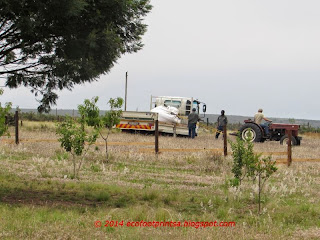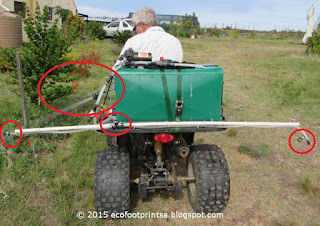For those who haven't seen it, it is a series documenting how 10 individuals handle being alone for the summer - having to fend for themselves on Vancouver Island with only the 10 survival items they are allowed to take with them apart from a change of clothing.
The one who stays out in the wilderness the longest will receive $500 000.
The latest episode we watched here was # 4 and the 10 guys are now down to 5.
To me it has been fascinating to watch their initial reactions when being placed alone at their different sites on Vancouver Island.
Unanimously, they all immediately tried to provide very basic shelter and then set about organizing heat and warmth for themselves.
Some were more successful than others. Some didn't succeed at all. Those that didn't left the show in the first and second episodes.
The next hurdle they tried to overcome was their fresh water requirement. Most of them resorted to boiling water collected from nearby streams at low tide, or "straining" water through sorghum (sphagnum?) moss.
I was fascinated, whilst simultaneously irritated, that not one of them thought to use their tents for rain water collection. It seems to have rained in every episode so far. As it's not falling from a residential, tiled roof area and down into gutters, whilst collecting bird poop along the way, but directly from the heavens, momentarily onto their tent / shelter roof, they wouldn't even need to boil it, for goodness sake!
In the last episode we watched one of the contestants finally provided food for himself (how have the others survived for 6 days with nothing to eat - apart from the one guy eating seaweed and a couple of small crustaceans?) Mitch managed to snare a fish in his net on the 5th day, and clean it and cook it. The commentary was that high tide only happens at night thus that was the only time that he could inspect his net and collect whatever it had trapped?!? Surely the tide rises and recedes twice a day? It does where I live.
Also, why does Mitch collect the fish from the net at night, when predators prowl? And cook it at night - thereby attracting predators (cougars) with the smell?
Sigh.
And these are survivalists?
I'm not, but even I know better than that.
Surely they should've done some research prior to taking part in this competition? That would've made them more methodical, prepared and able to face the hardship which they suddenly experienced e.g. what plants can be eaten? How can they trap small animals / marine life? How will they handle their shelter to protect them from the elements / predators? And, shouldn't they (couldn't they?) have taken a large chunk of biltong (jerky) as one of their 10 items - which would've provided them with an all important source of protein / energy / nourishment whilst they orientated themselves in their unfamiliar surroundings / situation.
Surely they should've done some research prior to taking part in this competition? That would've made them more methodical, prepared and able to face the hardship which they suddenly experienced e.g. what plants can be eaten? How can they trap small animals / marine life? How will they handle their shelter to protect them from the elements / predators? And, shouldn't they (couldn't they?) have taken a large chunk of biltong (jerky) as one of their 10 items - which would've provided them with an all important source of protein / energy / nourishment whilst they orientated themselves in their unfamiliar surroundings / situation.
Don't get me wrong. Hats off to them for being brave enough to take part. I could not imagine being alone anywhere at night - on my own - unless it was inside my house. I also don't envy them their "exposure" to bears, wolves or cougars. I do understand the psychological impact of suddenly being completely on your own. I have no problem being on my own - I enjoy my own company, and will always try and keep myself busy. But they all knew that they were going to be on their own, and would have to survive on their own when they entered the competition.
Didn't they?
Didn't they?
Given my (mostly mild, but at times intense) irritation, watching the series has been interesting as it has highlighted man's immediate need when out of their comfort zone / lost in the wilderness / in an unfamiliar situation for whatever reason.
Man's immediate requirements are:
1 Shelter and warmth / heat / fire (comfort / food preparation / protection from the elements and wild animals)
2 Water (to prevent dehydration)
3 Food (to feed their bodies / encourage / uplift their spirits)
4 Purpose (to keep the mind occupied and busy)
4 Purpose (to keep the mind occupied and busy)
To my inexperienced mind, if they had concentrated on building themselves a strong, secure as possible shelter using the wood / tree trunks in the forest (which was evident around each and every one of them) together with the tents they took with them - and they completed that on their first day, they would've been better off when they started their 2nd day - searching for food. I'm presuming here that they would've allowed for their tents to catch their drinking water - which they didn't.
My 10 survival items would've been:
1 Waterproof tent / tarpaulin
2 Waterproof sleeping bag
3 Knife - and a substantial one at that
4 Firestarter
5 Cooking pot - for heating water / cooking and eating whatever I managed to forage for / catch
6 A (preferably) large coil of nylon rope (30 - 50 mtrs?) It doesn't weigh that much, and would just be bulky)
7 Ax or saw (not sure which one would be more useful, but, after some thought, my choice would probably be an axe)
8 Bright LED torch - for sparing use in emergency situations only in order to prolong it's battery life
9 Collapsible spade / shovel to dig for roots / holes / or fixed on the end of a piece of wood with some of the nylon rope as an additional form of defense against predators. (Ditto the (substantial) knife could also be used as a harpoon / spear / weapon)
10 This will probably be a controversial one - a big slab of biltong (jerky), or a 5kg mixture of flour and dehydrated or powdered eggs (with which I could make some sort of flapjack / biscuit and which would provide me with protein and carbohydrates whilst I settled in to my new surroundings.) If that was not allowed according to the "game rules" then I would probably replace that with a notebook and pencil - to record experiences I want to remember / internal feelings that occur on the spur of the moment and are then lost after that moment has passed. How else can one learn from the experience?
Alone provides a good lesson in preparedness for all of us I guess - be that for calamitous natural disasters, substantial unrest or a complete collapse of the grid. The "predators" may be different, but the threat and emergency situation, especially in towns, would be enormous. Town dwellers would face a completely different set of challenges, wouldn't they?!
In the event that life as you knew it was thrown to the wind, would you know what to grab in a life and death situation to help you fend for yourself for an potentially extended period of time?
What would you do, and how / what would you prepare or take along? Have you taken any steps already to ensure your continued existence in the case of a major natural disaster, substantial unrest or complete collapse of the grid?
Thought provoking - no?
We have episode 6 to watch tonight...
In the event that life as you knew it was thrown to the wind, would you know what to grab in a life and death situation to help you fend for yourself for an potentially extended period of time?
What would you do, and how / what would you prepare or take along? Have you taken any steps already to ensure your continued existence in the case of a major natural disaster, substantial unrest or complete collapse of the grid?
Thought provoking - no?
We have episode 6 to watch tonight...















